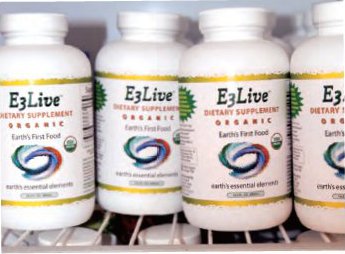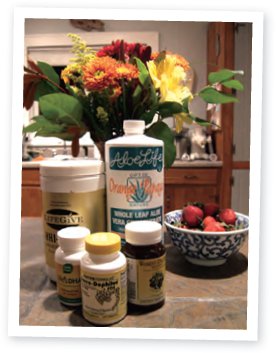
CHAPTER 9

SUPPLEMENTS
As we’ve been yakking about for the past several chapters, it’s best to get nutrients—vitamins, minerals, enzymes, oxygen, phytonutrients—from a whole, organic, plant-based diet. Yet there are healthful ways to augment and enhance your existing diet with what I call the foundationals. These are basic products (supplements, superfoods, protein powders) that boost your diet and your health. Make no mistake—supplements and pills are not food replacements, they are diet enhancements. They complement what you are doing in your diet!
What follows are my faves, but they’re just suggestions, along with explanations as to how these extras work in partnership with your Crazy Sexy Diet. For more information on foundational supplements, go to the crazysexylife.com store. We’re always updating with our favorite brands!
When shopping for supplements, buy the very best quality you can afford. There is a difference between mass-produced synthetic vitamins that have been sitting on the shelf at the drugstore for six months and smaller-batch brands made with fine organic ingredients that come from whole foods. To tailor a supplement and superfood plan specific to you, however, it’s a good idea for you to see a holistic doctor or naturopath for a customized plan.
PROBIOTICS
Let’s be real here: Sometimes your friendly bacteria could use a hand, such as when you don’t make the best food choices thanks to circumstances or desire, or you need to take drugs (maybe antibiotics) for an illness, or you undergo treatment like chemotherapy. That’s why the first foundational I recommend is a good probiotic supplement—a supplement that contains beneficial bacteria by the billions and can help restore the balance in your intestines. Literally meaning “for life,” probiotics are supplements containing zillions of dormant little bacteria, and they are taken to maintain or restore the body’s proper bacterial balance.
You’ll notice that the probiotics shelf is a big one in most health food stores today—they’ve caught on. How can you choose among all the different brands and claims? What you want are bacteria that give off lactic acid as a by-product of their metabolism. (Trust me, this is a good thing.) Lots of beneficial bacteria do this, including various strains of bifidobacteria, boulardii, acidophilus, and lactobacillus. Some brands have fructo-oligosaccharides, or FOS, added to them—these are natural sugars that help feed the beneficial bacteria and get them started in your small intestine. You can also find brands with added vitamins, minerals, amino acids, and other supplements.
No matter what brand you choose, look for one high in lactobacillus and bifidobacterium. The count should be in the billions (yes, billions with a b). In addition, choose those that are vegetarian and come in an enteric-coated capsule. The coating keeps the bacteria safely inside until the capsule leaves your stomach and enters your small intestine. Today most probiotics brands don’t need to be refrigerated—good for me, as I travel a lot. Dr. Ohhira’s is one such great brand. I also like Jarrow Formulas and PB8 brands. For just keeping things in balance, one or two capsules a day should be enough. If your intestinal flora are way off, you may need to take larger daily doses, possibly for several weeks or longer. Consult with a naturopath or integrative MD if you sense a bigger imbalance. They can order a comprehensive digestive stool analysis to see if you have an imbalance between good and bad bacteria.

A NOTE ON
antibiotics
Sometimes it just can’t be avoided—an antibiotic becomes necessary when you have an infection that just won’t go away on its own. The problem is, many antibiotics are overprescribed and become ineffective against the bugs they’re supposed to fight and kill. Ever-stronger versions are required, and meanwhile those buggies react by creating new, stronger forms of antibiotic-resistant “superbugs.” If you do have to take a course of antibiotics, take all the pills. Because antibiotics kill both good and bad bacteria in your intestines, when you’re done with the prescription, follow up with probiotics to restore the balance of good bacteria.
SUPERFOODS AND
PROTEIN POWDERS
A superfood is one especially rich in phytochemicals (natural and unique plant chemicals that have disease-fighting properties). Phytochemicals can reduce the risk of certain forms of cancer, reduce inflammation, strengthen the immune system, and in general contribute to a healthier more fab you.
Blue-green algae (BGA) harvested from Upper Klamath Lake in Oregon are a top superfood. E3Live (e3live.com) is a great brand. BGA provide a boost in energy and mental clarity, rebuild cells, and bind free radicals; they’re also high in vitamins and minerals.
Spirulina is a type of algae that’s high in chlorophyll and protein. Nutrex Hawaii (nutrex-hawaii.com) has a good spirulina called Hawaiian Pacifica.
Chlorella is another type of algae that helps raise pH levels, normalize bowel function, build your immune system, and bind heavy metals and radiation. If you have elevated levels of mercury (possibly from amalgam dental filings) or other environmental toxins, make chlorella your new BFF. Check out the Sun Chlorella brand at sunchlorellausa.com.
Green powders usually contain mostly dehydrated cereal grasses, such as wheatgrass and kamut. They should be used as a supplement, not in place of juicing. I love Amazing Grass brand (amazinggrass.com). You can toss a spoonful into your juice or a smoothie. Hemp powder is high in protein, and raw cacao and carob powders add antioxidants and flavor to smoothies. Nutiva (nutiva.com) has great hemp powder and seeds. Vegan triathlete Brendan Brazier’s Vega brand (sequelnaturals.com/vega) is another high-quality protein powder choice. So is Sun Warrior Protein (sunwarrior.com). They also make a green powder.
Browse superfood products made by Navitas (navitasnaturals.com). The company’s maca powder is great for the adrenals and sex drive. I won’t tell you how I know it helps. … MSM (methylsulfonylmethane) is a safe, natural, side-effect-free remedy for many types of pain and inflammatory conditions. MSM, also known as the beauty mineral, helps to create thick hair, clear soft skin, and strong nails. It also helps the tissues become more permeable, allowing nutrients to absorb and pass through while toxins move out. Rich’s brand makes a good product.
DON’T WORRY,
B HAPPY!
There’s only one vitamin you really need when you switch to an animal-free diet: B12. That’s because vitamin B12 isn’t found in plant food. It’s naturally produced by microorganisms in soil and water that hasn’t been contaminated or chlorinated. Animals eat unwashed plants and soil particles and drink water containing the organisms that make B12, but we don’t. Since you can’t make it in your body and you don’t get it from a vegan diet, you need to supplement. Just 2.4 micrograms per day will ensure you are getting what you need. It is the smallest daily requirement of any supplement.
Many nutritionists recommend taking a complete B vitamin supplement, which contains other members of the B family, such as folic acid (crucial for women of childbearing age). If you prefer to take only B12, sublingual lozenges dissolve under your tongue and the B12 gets absorbed straight into your bloodstream. Whichever way you go, choose a product that contains the B12 in the form of methylcobalamin—you absorb this best.

VITAMIN D
You need vitamin D for strong bones and a strong immune system. There’s plenty of evidence that vitamin D plays a powerful role in preventing cancer and heart disease. But if you’re like most Americans, chances are that you’re on the low side for vitamin D because we don’t spend enough time outdoors. In fact, at least half of all adults don’t get enough. And according to a 2009 article in the medical journal Pediatrics, more than 6 million American kids—about one in five—are deficient in D.
VITAMIN D with

Frank Lipman, MD, is the author of Revive: Stop Feeling Spent and Start Living Again and founder of the Eleven Eleven Wellness Center.
MULTI-SUPPLEMENTS
Aside from being careful to get enough vitamin B12 and vitamin D, you don’t really have to worry about the other vitamins and minerals when you eat a mostly raw, vegan diet. Or do you? Stuff happens, and sometimes you can’t eat the way you want to. And even when you can, other factors, like illness, food allergies, drug treatment, or even stress, mean that you might need extra on some vitamins and minerals.
To be on the safe side, I suggest taking a daily multivitamin/mineral supplement. Look for a brand that’s designed for adults and has at least 100 percent of the RDA for vitamin B12 if you are not also taking any B12 or B complex supplements. Make sure that it’s gluten-free and vegetarian. Quality counts in supplements—but that doesn’t always translate into price. Expensive doesn’t necessarily mean better. If you can’t afford a pricey daily supplement, there are high-quality affordable brands of multivitamins on the market that make it possible for you to never skip a dose.
OMEGA-3
SUPPLEMENTS
As I explained in chapter 4, your body needs essential fatty acids such as omega-3s just as much as it needs vitamins. And just as I suggest taking vitamin supplements to be absolutely certain you’re getting enough of what you need, I also suggest taking a daily omega-3 supplement. Look for one that gets the omega-3s from algae—that way you get a pure, animal-free product (no fish oil). I prefer enteric-coated capsules that don’t dissolve until they enter your small intestine—this helps avoid stomach upset and burpiness.
Remember that the capsules are supplements, not substitutes. You still want to have plenty of natural omega-3 sources in your diet, including nuts, seeds, beans, and vegetable oils (especially flaxseed). How much should you take? Capsules range from 200 to 1,000 mg. Generally speaking 1,000 mg (1 gram) a day should be enough. Larger doses can thin your blood a bit, which might be bad for you.
A great vegetarian supplement to add to your wellness arsenal is a product called Life’s DHA Omega 3 (learn more at lifesdha.com). Dr. Mehmet Oz first introduced me to this product when he made a house call to our Brooklyn pad to shoot my Oprah episode. The handsome and helpful doc arrived bearing gifts of a green drink, Life’s DHA supplements, and a pair of scrubs (which I still write in—so comfy!).
DIGESTIVE ENZYMES
I suggest taking daily digestive enzyme supplements. They take some of the load off your digestive system and let your body divert that energy to other purposes. And they make sure you have the enzymes you need, when you need them, to digest your food thoroughly and get maximum nutrition from it.
Add a digestive enzyme to your diet, especially when you’re eating animal products and/or cooked food. This will aid your body in proper digestion and elimination. Once we heat chow over 118 degrees, it loses its vitamins, minerals, and—most importantly—enzymes. Sooooo chow some enzymes to help everybody out!
You have a lot of choices when it comes to digestive enzymes—so many that this is one of the more confusing shelves at the health food store. Some supplements have ten or more enzymes in them. When making your choice, look for a supplement that has at least three kinds of enzymes: proteases, which help digest protein, amylases, which help digest carbohydrates, and lipases, which help digest fats. Some experts think you also need cellulase, an enzyme that helps break down insoluble fiber from cellulose, which is the main component of the cell walls in plants. Look for a supplement where the enzymes are all plant-based, since this is closer to what your body naturally produces. My favorites are sold at the Hippocrates Health Institute (hippocratesinst.org). They’re called LifeGive HHI-Zymes, and they come in a bucket of 650 caps. Enzymetica brand (enzymedica.com) has several fantastic products. Whatever brand you go with, take one or two capsules with each meal.
ALOE VERA
Last but not least, I’ve been sucking on Aloe Life Herbal Aloe Detox Plus Formula (aloelife.com). I put a capful or two in a liter of water and drink it all morning. Aloe is more than just a great sunburn remedy. In fact, numerous studies have shown aloe vera to be a general boost for your overall immune system.
Research has shown three major areas where aloe is effective: anti-inflammatory, antibacterial, and antiviral. The juice is said to soothe digestive tract irritations such as colitis, ulcers, and irritable bowel syndrome, according to a paper in the Journal of the American Osteopathic Society.
In one study, asthmatic subjects took aloe orally for six months, and nearly half of them reported a reduction or elimination of asthma symptoms. Aloe also contains protein, calcium, magnesium, zinc, vitamins A, B12, and E, and essential fatty acids; it’s naturally rich in calcium, vitamin C, natural enzymes, and germanium, a mineral that may help people with immunodeficiency diseases, chronic pain, and heart and circulatory problems.
Natural anti-inflammatory substances and analgesics are present in the gel-like yellow sap of aloe’s plump leaves, and that glorious goo can reduce swelling, pain, and skin irritation.
FULL SPECTRUM
For those of you who have never downed any kind of vitamin other than a chewable Fred Flintstone, the previous list might seem pretty long. Yet I’ve known people who take a separate carry-on when flying just to carry their vitamins, powders, potions, and pills! That’s overdoing it. The CSD is super-healthy, and the aforementioned give your system an extra boost. My feeling is if you buy the best, most high-quality vegetarian supplements from reliable sources, they can play a part in your ongoing vitality, shimmer, and spark!
 testimonial: Miri E.
testimonial: Miri E.
I’ ve been following Kris Carr and the Crazy Sexy lifestyle for about two years. I could go on and on about the physical benefits of this amazing lifestyle: clear skin, tons of energy and focus, my immune system is unbelievable, my blood tests are all fine, I’m strong and happy, and much more. For me, besides feeling in credible physically, the CSD minimized the monster in the big C and made it like a shadow on the wall. Kris Carr and the CSD lifestyle have given me what no one else could: empowerment! This lifestyle taught me how to live and be a better me. It shows me that I have choices and options; that I do not need to live with fear anymore. It taught me that I have a tremendous inner strength, and gave me lots of tools to live my life to the fullest. It taught me that canSer is not just about life and death, it’s about doing and being my best in between; it taught me to be happy regardless. I learned that I can control what goes inside my body. I choose the best in every single bite and every single thought.
CHAPTER  IN REVIEW
IN REVIEW
REMEMBER:
 Food is the best source of nutrients, but we can also use a little help from our friends: supplements and superfoods.
Food is the best source of nutrients, but we can also use a little help from our friends: supplements and superfoods.
 Probiotics are great for balancing good bacteria—look for one high in lactobacillus and bifidobacterium.
Probiotics are great for balancing good bacteria—look for one high in lactobacillus and bifidobacterium.
 Superfoods are rich in phytochemicals that reduce the risk of certain forms of cancer, reduce inflammation, strengthen the immune system, and in general contribute to a healthier, more fab you.
Superfoods are rich in phytochemicals that reduce the risk of certain forms of cancer, reduce inflammation, strengthen the immune system, and in general contribute to a healthier, more fab you.
 Make sure you’re getting enough B12.
Make sure you’re getting enough B12.
 Get your vitamin D from a supplement when you can’t get it from the sun.
Get your vitamin D from a supplement when you can’t get it from the sun.
 Give your brain a boost with omegas.
Give your brain a boost with omegas.
 Digestive enzymes help what? Digestion!
Digestive enzymes help what? Digestion!
 Aloe vera is anti-bad-stuff in a big way.
Aloe vera is anti-bad-stuff in a big way.